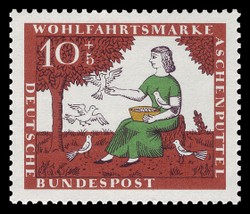Goose Girl is a very characteristic fairy tale with numerous well-known elements which can be found in other classic stories for kids. The main character (namely princess) starts her personal quest in high social and economic position just to be defeated by forces from outside (namely her treacherous servant) but with a help of an indisputable authority (namely king, father of her fiancee) and a pinch of magic regains her status and finishes the story in even better position than before.
Such plot is the most popular in fairy tales (same is true for a huge part of fiction), yet not enough for a successful story. To become truly evergreen it has to possess some elements which are, with a bit of practice, easily recognizable in other 'classics' as well. Here is a top 10 list of characteristic elements in The Goose Girl with short symbolic interpretations and other not so obvious meanings.













 Vintage Postcard Artists with 10 Examples of Easter Cardson 02/21/2025
Vintage Postcard Artists with 10 Examples of Easter Cardson 02/21/2025
 Valentine's Symbolson 01/23/2025
Valentine's Symbolson 01/23/2025
 Thanksgiving Symbolson 11/12/2024
Thanksgiving Symbolson 11/12/2024
 Famous Witches in Literary Historyon 10/06/2024
Famous Witches in Literary Historyon 10/06/2024



Should we mention more symbols and reveal more hidden meanings in the Goose Girl?
Seven times beauty was written by Bechstein, the other two by Grimms.
Thank you!
Seven times beauty and Brave little tailor and Doctor-Know-All are unfamiliar to me. It'll be an intellectual treat to look into them.
Nope, DerdriuMarriner, in fairy tales parents give stuff to their children, just like it is with genetics.
Yes, it is, DerdriuMarriner. From the top of my head I can think of Seven Times Beauty by Bechstein and Doctor-Know-All and Brave Little Tailor by Grimm.
The in-text images above include two illustrations of a boy chasing his hat.
The first link in the last, Resources subheading, makes available your commented pictures of various Goose-Girl scenes. Artist Charles Robinson names the boy Conrad.
What significance would someone who seems like just a background figure have for the Goose-Girl plot?
The in-text image between the first and second symbols, All kinds of treasures and Handkerchief, has one statue of perhaps a lion on the other side of the Queen and the subsequent Goose Girl as well as two live dogs.
Is there some symbolism regarding the canine and the leonine appearances?
The last symbol, Iron stove, causes me to consider iron symbolically elsewhere.
Does someone such as a blacksmith deserve respect for delivering iron done up to torture evildoers?
For examples, Snow White's mother expires in a pair of red-hot iron slippers.
The 10th symbol, Iron stove, informs us that "An iron stove actually connects two symbols. One is the material itself. Iron is associated with magical powers in many societies. Especially its protective force fascinated people for centuries. You can kill with iron and you can make armor of iron. Making an iron from ore is not an easy task. Somebody who works anything related to iron (miner, blacksmith, ...) is a person who deserves respect."
Is the person who wields iron, such as a warrior, worthy of respect different from or the same as such iron-workers as blacksmiths and miners?
The 9th symbol, Wind, appears positively as "symbol of breath, another crucial element of life. While invisible, wind causes many obvious changes, demonstrating its power in many ways."
Power can be for evil or for good. Do fairy tales always, never, sometimes show a "bad side" to powerful wind?
The eighth symbol, Water, appears in its water-body form as fresh-watered brooks and streams for drinking.
It considers in its first paragraph that "it helps plants to grow" for an implied association with rain water.
Unitedstatesian films depict cleansing, reconciling, transformational moments with steadily falling rain. Is that an interpretation atypical or typical of fairy tales?